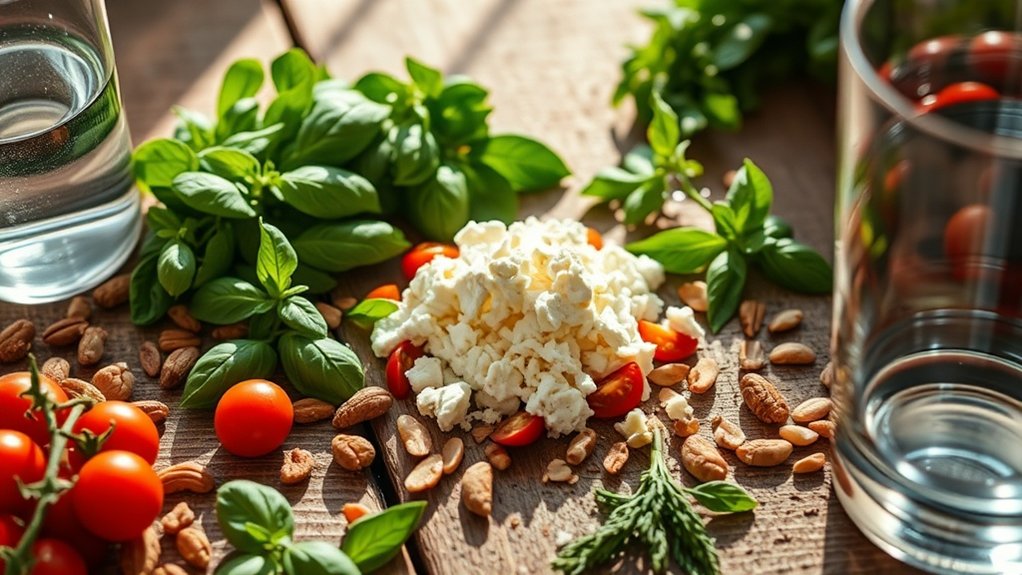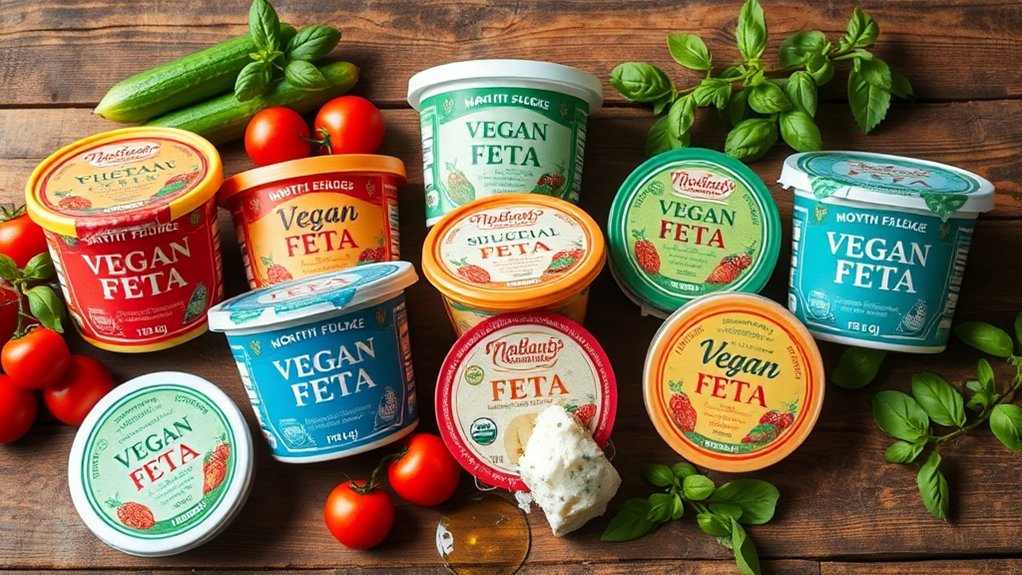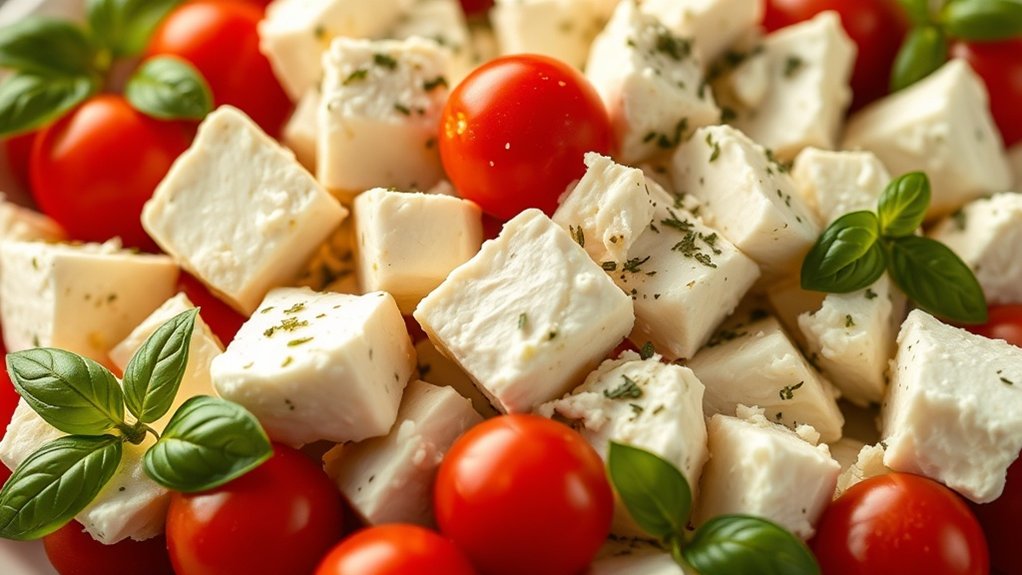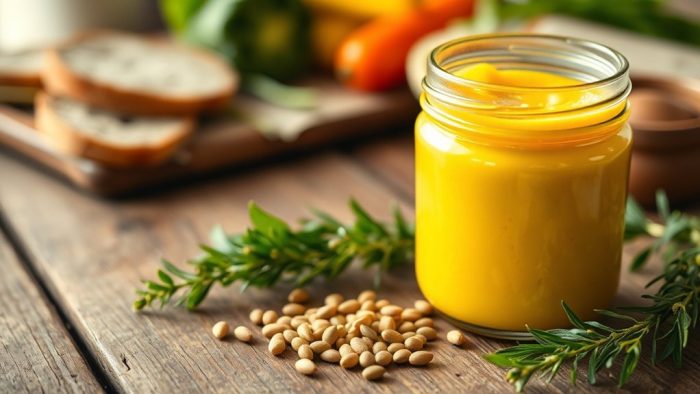Is Feta Vegan

No, traditional feta cheese isn’t vegan because it’s made from sheep’s or goat’s milk and typically contains animal-derived rennet from calf stomach lining. The production directly supports the dairy industry and contains lactose, making it incompatible with plant-based diets. However, you’ll find numerous vegan alternatives available, both store-bought and homemade, that replicate feta’s signature tangy, briny flavor and crumbly texture using ingredients like tofu, cashews, and nutritional yeast. Below, we’ll investigate how these plant-based versions compare nutritionally and how you can incorporate them into your favorite Mediterranean dishes.
What Is Traditional Feta Cheese and How Is It Made?

Traditional feta cheese stands as one of Greece’s most iconic culinary contributions, with documented production dating back to 1494.
You’ll find traditional feta primarily crafted from sheep’s milk, though some variations incorporate goat’s or cow’s milk.
The production process begins when cheesemakers add bacteria culture and rennet to warmed milk, initiating coagulation.
Once the whey drains away, the remaining solid forms into blocks with feta’s characteristic soft, crumbly texture.
The cheese develops its distinctive salty, tangy flavor through aging in a brine solution, which also acts as a preservative.
This brining process, combined with the cheese’s higher water content, results in a lower fat profile compared to harder cheese varieties while maintaining its creamy consistency and bold taste.
Why Traditional Feta Cheese Is Not Vegan
Traditional feta cheese fails to meet vegan standards due to three fundamental components in its production.
The cheese is made from sheep’s or goat’s milk, which are animal-derived ingredients that directly contradict vegan dietary principles.
Additionally, the manufacturing process typically employs rennet extracted from the stomach lining of slaughtered calves, and the final product contains lactose—a milk sugar inherent to all dairy products.
Animal Milk Base Ingredient
At its core, feta cheese derives from animal milk—predominantly sheep’s milk or a sheep-goat blend—which immediately disqualifies it from vegan dietary standards.
You’ll find that this dairy foundation creates several concerns for plant-based eaters. The production process involves coagulating milk with rennet, an enzyme extracted from slaughtered calves’ stomach lining, adding another layer of animal exploitation.
When you’re seeking dairy-free feta alternatives, understanding these ethical implications becomes essential. Traditional cheese production directly supports the dairy industry, which conflicts with vegan principles. The lactose content and animal-derived ingredients make feta incompatible with plant-based diets.
Fortunately, you can now find dairy-free feta options made from nuts, tofu, or coconut oil that replicate the tangy, salty profile without animal ingredients.
Rennet From Slaughtered Calves
Beyond the milk itself, rennet extraction represents one of the most ethically problematic aspects of feta production for those following plant-based diets.
Traditional feta relies on animal-derived rennet—an enzyme sourced from the stomach lining of slaughtered calves—to facilitate the cheese-making process. This enzyme coagulates milk, separating curds from whey and creating feta’s distinctive texture and flavor.
Since rennet extraction requires animal slaughter, feta can’t be considered vegan under any circumstance. While some cheeses now use microbial or vegetable rennet, authentic feta mainly contains calf rennet.
This reality drives vegan consumers toward plant-based alternatives crafted from tofu or nuts, which replicate feta’s tangy profile without animal exploitation. Understanding rennet’s origin clarifies why traditional feta fundamentally conflicts with vegan principles.
Lactose and Dairy Content
While rennet presents a significant ethical concern, the fundamental barrier to feta’s vegan status lies in its primary ingredient: animal milk.
Traditional feta cheese is made from sheep’s milk or sheep-and-goat milk combinations, making it definitively a dairy product. This means feta contains lactose, the natural sugar found in animal milk that’s incompatible with vegan diets.
The cheese’s characteristic creamy texture and tangy flavor derive directly from these animal-derived ingredients. You’ll find that even vegetarians who consume dairy recognize feta as non-vegan due to its milk content.
However, the growing demand for plant-based options has led manufacturers to develop vegan alternatives using cashews, almonds, or tofu, which replicate feta’s texture and taste without animal-derived ingredients.
Nutritional Profile: Dairy Feta vs. Vegan Alternatives
How do dairy and vegan feta compare nutritionally? Understanding the nutritional content helps you make informed choices.
Dairy feta contains approximately 75-80 calories per ounce with 6 grams each of protein and fat, mostly saturated fat. It’s high in sodium (300-400 mg per ounce) but provides calcium and vitamin B12.
Vegan alternatives typically offer:
- Lower calories (50-70 per ounce) and reduced saturated fat
- Dairy-free composition, making them suitable for lactose-intolerant individuals
- Fortification options with B12 and other nutrients absent in plant sources
Vegan feta made from tofu or nuts varies greatly in nutritional profile depending on ingredients.
While dairy feta provides complete protein, vegan alternatives often contain less protein.
Both options deliver the distinctive tangy flavor, allowing you to choose based on dietary needs and health goals.
Store-Bought Vegan Feta Brands Compared

Now that you understand the nutritional differences between dairy and vegan feta, you’ll want to know which store-bought options deliver the best taste and texture.
Follow Your Heart offers soy-free and gluten-free crumbles, accommodating multiple dietary restrictions.
Violife’s Greek-style feta features coconut oil as its base and includes B12 fortification, delivering a creamy texture that mimics traditional feta.
Good Planet Foods distinguishes itself by incorporating olive oil, olives, and oregano into their Greek-style feta, creating an authentic Mediterranean flavor profile.
Sheese has earned award nominations for its Greek Style option, demonstrating its quality in replicating conventional feta’s characteristics.
Each brand uses different base ingredients and fortification strategies, so you’ll need to evaluate your specific nutritional requirements and taste preferences when selecting store-bought vegan feta.
How to Make Homemade Vegan Feta Cheese
Making vegan feta at home gives you complete control over ingredients, sodium levels, and flavor intensity while costing considerably less than store-bought alternatives.
This delicious vegan cheese works perfectly in Greek salad and other vegan recipes.
To make vegan feta using the tofu method:
- Prepare the base: Drain and press extra-firm tofu for 30 minutes, then cut into small cubes.
- Create the marinade: Combine olive oil, lemon juice, vinegar, garlic, and herbs in a container.
- Marinade in the fridge: Coat tofu thoroughly and refrigerate 12-48 hours for ideal flavor absorption.
For a creamier vegan feta cheese recipe, blend cashews and almonds with coconut oil and miso, then refrigerate until firm.
Use it to make salads, pasta, or stuffed vegetables. Homemade versions keep well refrigerated for one week.
Replicating Feta’s Texture and Flavor in Plant-Based Versions

Creating a convincing plant-based feta requires understanding the cheese’s distinctive briny, tangy flavor profile and its characteristic crumbly texture.
You’ll need to incorporate acidic elements like lemon juice or vinegar alongside salty components such as olive brine or miso paste to replicate feta’s sharp taste.
The texture challenge involves selecting the right base—whether extra-firm tofu for its ability to crumble or blended nuts for a creamier consistency that firms when chilled.
Key Flavor Components
When replicating feta’s distinctive profile in plant-based versions, you’ll need to target three essential elements: saltiness, tanginess, and umami. These key flavor components can be successfully achieved through strategic ingredient selection.
Core Ingredients for Authentic Flavor:
- Tanginess and Umami: Combine lemon juice with nutritional yeast and miso to deliver the characteristic sharp, fermented notes.
- Briny Saltiness: Incorporate olive brine or pickling liquid into your marinade for authentic Mediterranean flavor.
- Savory Depth: Add garlic powder, onion powder, and dried oregano to improve savory notes.
Start with extra-firm tofu as your base—when pressed and marinated for up to 48 hours, it absorbs these flavors thoroughly while developing the crumbly texture traditional feta is known for.
This extended marination guarantees a richer, more authentic taste.
Achieving Crumbly Texture
While flavor matters immensely, texture distinguishes exceptional plant-based feta from mediocre versions. Achieving that characteristic crumbly texture requires starting with extra firm tofu, pressed for at least 30 minutes to remove excess moisture. This preparation allows better marinade absorption and firmer consistency.
For vegan feta, incorporate nutritional yeast, lemon juice, and olive brine into your marinade—these ingredients improve flavor while contributing to the desired crumbly texture. Alternatively, blending soaked cashews or almonds with coconut oil creates a creamier base that firms up when cooled.
Marinating proves critical for plant-based versions. Whether using tofu or nut-based mixtures, marinating for 12 to 48 hours dramatically improves both flavor complexity and textural authenticity, transforming simple ingredients into convincing feta alternatives.
Using Vegan Feta in Mediterranean Dishes
Mediterranean cuisine transforms beautifully with vegan feta, which delivers the signature tangy, briny flavor essential to the region’s most beloved dishes.
You’ll find this plant-based cheese excels in traditional preparations while maintaining authentic taste profiles.
Consider these versatile applications for vegan feta:
- Greek salads: Crumble it over fresh vegetables and olives to recreate the classic dairy-free experience.
- Mediterranean pasta salads: Add savory depth with its briny flavor that enriches herb-forward dressings.
- Stuffed vegetables: Fill peppers and tomatoes with seasoned vegan feta for a rich, protein-dense preparation.
You can also use vegan feta as a topping for flatbreads and pizzas, creating cheesy vegan adaptations without compromising texture or flavor.
This ingredient logically integrates into Mediterranean cooking while supporting plant-based dietary goals.





